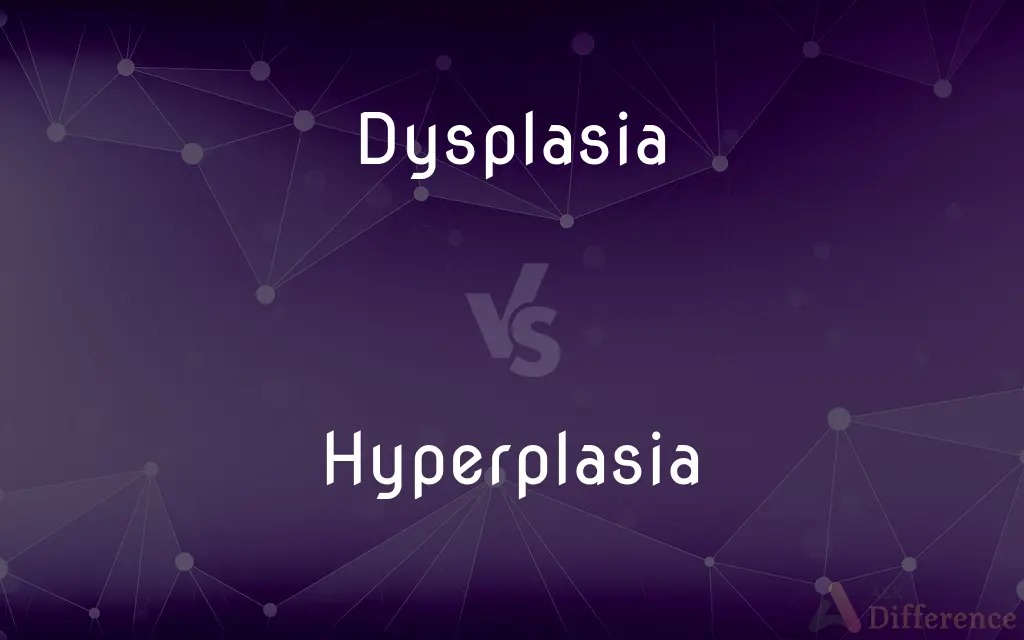Dysplasia vs. Hyperplasia — What's the Difference?
By Tayyaba Rehman — Updated on November 5, 2023
Dysplasia is abnormal cell growth within a tissue, which can be precancerous, while hyperplasia is the increase in cell number due to a response to a stimulus, typically reversible.

Difference Between Dysplasia and Hyperplasia
Table of Contents
ADVERTISEMENT
Key Differences
Dysplasia and hyperplasia are both terms related to cell growth and proliferation. Dysplasia refers to the abnormal development or growth of cells, tissues, or organs, often implying an atypical appearance that may be precancerous. Hyperplasia, in contrast, is a noncancerous increase in the number of cells in an organ or tissue, leading to an increase in tissue size.
In the context of pathology, dysplasia is often considered a precancerous or potentially malignant process, reflecting changes in the size, shape, and organization of cells. Hyperplasia is typically a benign increase in cell numbers that results from a physiological response or the abnormal proliferation of normal cells.
The causes of dysplasia can include chronic irritation or inflammation, and it may be reversible if the irritant is removed. Hyperplasia often occurs as a hormonal response or as a result of an increase in demand for tissue regeneration and is usually a reversible process when the stimulus is withdrawn.
While dysplasia can signal the early stages of cancer and may require clinical intervention or monitoring, hyperplasia can often resolve on its own and does not necessarily indicate a progression to cancer. It is important, however, for both conditions to be evaluated by a healthcare professional to determine the appropriate course of action.
Comparison Chart
Definition
Abnormal cells indicating an atypical appearance
Increase in cell number due to normal cell proliferation
ADVERTISEMENT
Implication
Can be a precursor to cancer
Usually benign and reversible
Cause
Chronic irritation, inflammation
Hormonal, demand for tissue repair
Cell characteristics
Atypical size, shape, and organization
Normal appearance, increased quantity
Clinical significance
May require monitoring or intervention
Often resolves without treatment
Compare with Definitions
Dysplasia
An atypical cellular appearance found during histological examination.
The biopsy revealed dysplasia, necessitating further medical investigation.
Hyperplasia
A response to a stimulus resulting in tissue enlargement.
Gingival hyperplasia can be a side effect of certain medications.
Dysplasia
Abnormal growth of cells within a tissue.
Cervical dysplasia is often detected through a Pap smear.
Hyperplasia
Noncancerous proliferation of normal cells.
Adrenal hyperplasia can affect hormone levels in the body.
Dysplasia
Disordered cell development or maturation.
Hip dysplasia in dogs can lead to arthritis.
Hyperplasia
Tissue growth that can be reversed when the stimulus is removed.
The hyperplasia subsided once the hormonal treatment was stopped.
Dysplasia
Pathological abnormality in cells indicating possible early cancer.
Dysplasia detected early can improve the success of treatment options.
Hyperplasia
Increase in cell number due to physiological demand.
BPH is a type of hyperplasia of the prostate gland.
Dysplasia
A precancerous condition in epithelial tissue.
Dysplasia in the lining of the esophagus can result from long-term acid reflux.
Hyperplasia
Cellular reproduction causing organ size increase.
Muscle hyperplasia is a goal of some bodybuilders.
Dysplasia
Dysplasia is any of various types of abnormal growth or development of cells (microscopic scale) and/or organs (macroscopic scale), and/or the abnormal histology or anatomical structure presumably resulting from such growth. Dysplasias on a mainly microscopic scale include epithelial dysplasia and fibrous dysplasia of bone.
Hyperplasia
Hyperplasia (from ancient Greek ὑπέρ huper 'over' + πλάσις plasis 'formation'), or hypergenesis, is an increase in the amount of organic tissue that results from cell proliferation. It may lead to the gross enlargement of an organ, and the term is sometimes confused with benign neoplasia or benign tumor.Hyperplasia is a common preneoplastic response to stimulus.
Dysplasia
Abnormal development or growth of tissues, organs, or cells.
Hyperplasia
An abnormal increase in the number of cells in a tissue or organ, with consequent enlargement of the part or organ.
Dysplasia
(pathology) Abnormal development of cells or tissue, often a precancerous stage of growth.
Hyperplasia
(medicine) An increase in the size of a tissue or organ due to increased number of cells.
Dysplasia
Abnormal development (of organs or cells) or an abnormal structure resulting from such growth
Hyperplasia
An increase in, or excessive growth of, the normal elements of any part.
Hyperplasia
Abnormal increase in number of cells
Common Curiosities
Can dysplasia be found in any organ?
Dysplasia can occur in any tissue, often in epithelial layers.
Can hyperplasia affect hormone levels?
Yes, especially in glandular tissue like the adrenal glands.
Can dysplasia turn into cancer?
Yes, dysplasia can progress to cancer if not treated or monitored.
Is hyperplasia always benign?
Hyperplasia is usually benign, but it should be evaluated by a doctor.
How is dysplasia treated?
Treatment varies and can include monitoring, surgery, or other interventions.
Are there symptoms associated with dysplasia?
Dysplasia itself may not have symptoms but can be associated with other symptomatic conditions.
Can dysplasia be inherited?
Some forms, like skeletal dysplasias, can be genetic.
Is hyperplasia a sign of cancer?
Not typically, but it can coexist with cancerous conditions.
Is dysplasia reversible?
In some cases, if the causative factor is eliminated, dysplasia can be reversible.
What is nodular hyperplasia?
It's a type of hyperplasia where nodules form in an organ.
Can exercise induce hyperplasia?
Certain types of exercise can lead to muscle hyperplasia.
Does hyperplasia require surgery?
Surgery is not always necessary and depends on the condition's cause and symptoms.
What is compensatory hyperplasia?
It's an increase in cell number to compensate for a loss or damage.
Does dysplasia cause pain?
It does not typically cause pain unless it's associated with other conditions.
Can dysplasia be detected early?
Yes, with regular screenings like Pap smears for cervical dysplasia.
Share Your Discovery

Previous Comparison
Petite vs. Small
Next Comparison
Concept vs. IdeaAuthor Spotlight
Written by
Tayyaba RehmanTayyaba Rehman is a distinguished writer, currently serving as a primary contributor to askdifference.com. As a researcher in semantics and etymology, Tayyaba's passion for the complexity of languages and their distinctions has found a perfect home on the platform. Tayyaba delves into the intricacies of language, distinguishing between commonly confused words and phrases, thereby providing clarity for readers worldwide.














































